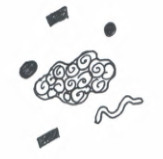Scavenging
Scavenging signifies the capture of aerosols by water droplets or ice crystals. This can take place in-cloud, or below the cloud as droplets rain out. Scavenging leads to wet deposition.
When airborne particles have the size of cloud condensation nuclei (typically a few hundred nanometers), water vapour may condense onto them and cloud droplets are formed. These droplets scavenge aerosols (including nanoparticles) in the cloud, with particular efficiency in the case of smaller aerosol particles. One should note that in the cloud water, gases may be taken up and chemical reactions may alter the chemical composition of aerosols.
When they have attained a certain size, formed droplets may rain out, which constitutes an efficient removal mechanism of particles (including nanoparticles) from clouds. Falling droplets may also scavenge aerosols below the cloud. This scavenging is most efficient for very small and very large aerosols, with a minimum efficiency in the range 0.1-1 µm.
|
|
Occurs in |
|
|
Fate descriptors |
Algorithms |
|
|
\(\lambda_{icp} = \frac{4.2 x 10^{-7}E_{c}\cdot P}{d_{d}}\) \(\lambda_{aq} = \frac{4.2 x 10^{-7}E_{c}\cdot P}{d_{d}}\) |
Read more |
Read also |
|
In NanoFASE in-cloud scavenging and below-cloud scavenging are used as described in the LOTOS-EUROS documentation. All aerosol is assumed to be in cloud-water within the clouds. |
Seinfeld, J. H. and Pandis S. N., Atmospheric Chemistry and Physics: from air pollution to climate, Wiley- Interscience, Hoboken, N.J., 2006. |
Contact
 Astrid Manders
Astrid Manders




